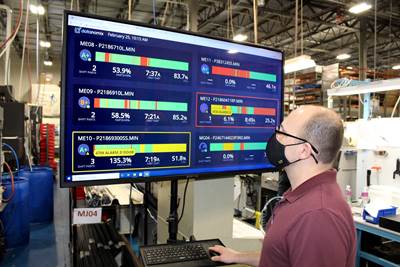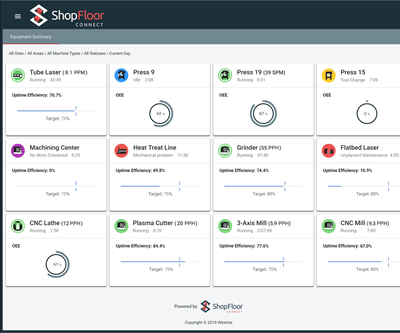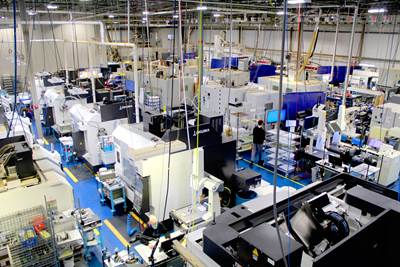Machine Monitoring Spurs Shop's Meteoric Growth
EPTAM Precision Plastics has achieved multiple years of 15% YoY growth by effectively applying Datanomix’s benchmarking and machine monitoring features.
Share









ECi Software Solutions, Inc.
Featured Content
View More

Autodesk, Inc.
Featured Content
View More
EPTAM Precision Plastics has relied on machine monitoring and benchmarking from Datanomix for years, using it during the early days of the COVID-19 pandemic to optimize production and meet rising demand for semiconductor parts. This success (which we previous covered in 2021) proved to be only the first of many, and EPTAM has continued to implement new Datanomix features to achieve multiple years of 15% year-over-year growth.

Through its years of using Datanomix, EPTAM Precision Plastics has relied on the software’s utilization benchmarking features. When performance regularly drops in comparison to a senior machinist’s initial run, the shop knows to focus on that area for continuous improvement projects. Images courtesy of Datanomix.
Growth Tracking
When EPTAM Precision Plastics first began implementing Datanomix, the Northfield, New Hampshire, facility used about 75 CNC machines to create plastic and metal parts. After several years of rapid expansion, the facility now has 110 CNC machines, 80 of which are connected to Datanomix. Those machines that aren’t connected to Datanomix are older machines that lack Ethernet ports and can’t communicate with the DNC — though the plant plans to swap them out for updated machines compatible with Datanomix over the next few years.
For its connected machines, EPTAM still relies on Datanomix Benchmarks (formerly known as Fusion Factors), which rate each machine’s productivity according to a benchmark that constantly recalibrates in response to real machining performance, but the facility now combines this information with data about product movement and cost breakdowns from EPTAM’s ERP software. Datanomix then turns this combination of ERP data and machine monitoring data into a Daily Operations Report analyzing each day’s production, broken down by value streams and departments throughout EPTAM. Plant Operations Manager Jesse Bunnell says that data should correlate between the ERP and Datanomix sides of the report. “If there is not a direct correlation, that is a red flag,” he says. “The appropriate leaders or managers make a note of it and take action.”
Breaking Through Utilization Ceilings
That “action” can take many forms but usually requires examining data from Datanomix in further detail. Key to dealing with unexpected downtime is the software’s Downtime Insights feature, which categorizes downtime reasons without requiring operator input. Bunnell says the facility’s most common downtime cause is a “missing operator” as the machine waits for an operator to clear chips or verify an alert. This alert can be especially difficult to solve for second and third shifts, which Bunnell says the facility has not been able to fully staff.
Most improvements therefore come down to the After Action Report, a feature that enables Bunnell and the EPTAM team to tag machines and jobs that are having trouble reaching their necessary productivity. The system saves the performance of the machine and job as a baseline. From there, the EPTAM team can experiment with machining parameters to see what effects they have on the machining process and whether they enable the job to meet its profitability requirements.
EPTAM does not directly quote through Datanomix, but by inputting the quote from its quoting software, Datanomix can analyze productivity and determine cycle time targets for profitability. The software can perform this analysis midway through a job, enabling the company to make changes partway through a day instead of only catching issues after the accounting department reviews the completed job. If the shop is unable to meet a quote after dialing in machining parameters through the After Action Report, EPTAM then drills down to see if there is a misquote or a misunderstanding about machining capabilities.
The granularity of Datanomix’s reports has also come in handy for EPTAM as it qualifies the repeatability of its parts. Bunnell cites a recent project that required operations qualification and performance qualification, noting that “if we see some anomalies in the metrology side of this product, we can actually cross-reference that to when these parts had run on the machine and see if there was something happening in the machine. For example, if we look back at the data and Datanomix says the machine sat for 15 minutes — and that machine does not have thermal compensation,” then EPTAM can take steps to ensure that machine is properly warmed up before cutting operations.

Datanomix’s benchmarking works in tandem with the shop’s quoting software to determine the maximum cycle time on a part that would still result in profitability, then keeps operators aware of how close machines are running to this boundary.
The OEE Equation
Dialing in machining parameters and solving for unforeseen difficulties is not just a task EPTAM takes on for new jobs, but also for new machines. The rapid expansion of EPTAM Precision Plastics’ CNC machining fleet from 75 machines to 120 has meant the facility’s OEE has not grown as quickly as its productivity increases would suggest. Bunnell says Datanomix has proved useful for finding machines’ most productive parameters, but continuous improvement staff cannot be everywhere in the shop at once.
For established, production-focused machines, however, Bunnell was able to point to a growth in OEE from about 35% to around 60% in a 12-month period. This is shy of EPTAM’s 77% OEE goal, but a massive improvement from where the shop started before adopting Datanomix. As with the “missing operator” downtime insight, Bunnell points to difficulty in fully staffing the facility’s second and third shifts as the primary challenge in maximizing machine utilization.
As a result, EPTAM Precision Plastics has continued to expand a robotic automation initiative it began in 2019 to increase the uptime of its machines. These robots perform a variety of processes from loading and unloading to product conformance verification to in-process deburring.
Datanomix has aided in EPTAM’s automation transition just as it does for the company’s staffed operation. Just as the software provides downtime reasoning for machines, the software can identify where robots stop and why in real time. Bunnell also says After Action Reports work well with robots, establishing functional baselines and enabling the shop to test different process changes to maximize robotic operation and uptime. During the handful of months EPTAM needs to optimize the performance of newly automated cells, the automation engineer works off this data in tandem with manufacturing subject matter experts and the quality team to ensure that production is successful on both efficiency and quality standards.
Whereas even the most productive machining groups at the facility averaged around 65% productivity before the introduction of robots, machine groups paired with optimized robots see reduced staff strain and can perform weekend operations, leading to about 78% utilization.
Eliminating the Paper Chase
By automatically gathering data from the machines and sorting it into actionable reports for stakeholders at different levels of management across the facility, Datanomix eliminated a large portion of the legwork associated with data collection and continuous improvement. Bunnell says the greatest challenge the facility has faced with Datanomix is properly conveying to the shopfloor team that this software is meant to support their work, not act as a way to blame operators for any production difficulties.
“To assume it’s a people issue out of the gate is just not a good way to conduct business,” Bunnell says. With EPTAM’s growth continuing at its meteoric pace, this philosophy appears to be correct.
Related Content
4 Commonly Misapplied CNC Features
Misapplication of these important CNC features will result in wasted time, wasted or duplicated effort and/or wasted material.
Read MoreERP Provides Smooth Pathway to Data Security
With the CMMC data security standards looming, machine shops serving the defense industry can turn to ERP to keep business moving.
Read MoreHow to Mitigate Chatter to Boost Machining Rates
There are usually better solutions to chatter than just reducing the feed rate. Through vibration analysis, the chatter problem can be solved, enabling much higher metal removal rates, better quality and longer tool life.
Read MoreCutting Part Programming Times Through AI
CAM Assist cuts repetition from part programming — early users say it cuts tribal knowledge and could be a useful tool for training new programmers.
Read MoreRead Next
Machine Monitoring Has a Lot to Learn
Supplementing CNC connections with sensors and machine learning enables predicting performance on the level of the individual part.
Read MoreMachine Monitoring Provides an Objective Lens
Automatic, real-time shopfloor data collection tempers the bias that blinds manufacturers to the real reasons for downtime.
Read MoreDatanomix Fusion Enables EPTAM to Visualize Facility, Optimize Resources
Faced with rising customer demand for high-precision parts EPTAM Precision Plastics used Datanomix Fusion to streamline data collection, improve quote accuracy and discover training gaps.
Read More




















.png;maxWidth=150)




















